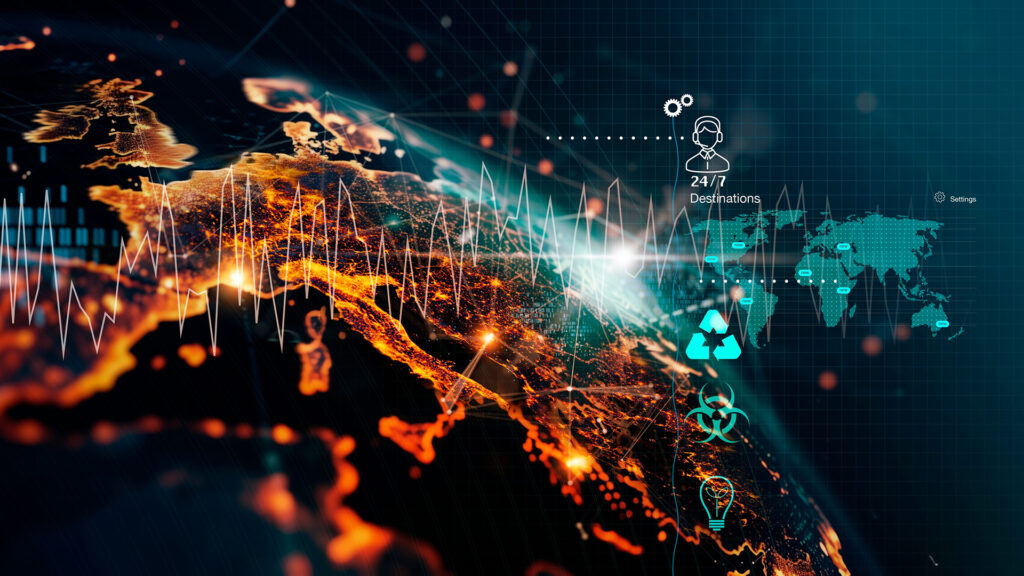RSS-Hydro explores how cutting-edge space technology and AI can revolutionize Earth observation and promote climate resilience through faster, smarter, and more sustainable solutions.
The urgent climate change challenge calls for innovative solutions that are not only effective, but also fast, sustainable and affordable. Groundbreaking advances in space platforms, satellite communications (SATCOM), and Earth Observation (EO) missions, coupled with the power of artificial intelligence (AI), are rapidly changing the ability to achieve climate resilience. This “all-in-space” approach, exemplified by companies like Luxembourg-based RSS-Hydro, leads a new era of aggressive environmental management and disaster response.
Building Climate Resilience: The Important Impact of Space Technology and AI
The convergence of advanced space platforms, high-throughput SATCOM and sophisticated EO missions is creating a paradigm shift in interaction with the Earth. This new era offers numerous benefits across key domains, leading to the future through more climate-sensitive, faster, more sustainable and affordable means.
Strengthening disaster management
Imagine a world where floods are detected and alerts are sent with pinpoint accuracy a few weeks ago. This vision is rapidly becoming a reality, changing disaster preparedness and response. Early warning systems for floods, wildfires and other climate-related disasters are more accurate and timely, allowing authorities and communities to take proactive measures to reduce damage and save lives.
RSS-Hydro’s Floodpin is an all-in-space service solution that leverages satellite imagery, hydrological know-how and AI, currently under development and provides accurate and timely flood insights and impact assessments that act as a game changer for disaster preparedness. By deploying advanced algorithms directly into orbit on satellite infrastructure, it significantly reduces latency in generating and delivering critical information after a disaster. This approach bypasses traditional ground-based processing bottlenecks and allows for near-real-time insights such as event mapping and initial impact assessments, so that stakeholders can be contacted within minutes. This speed and efficiency are essential for timely and effective emergency response across a variety of disaster types.
Urban Planning and Infrastructure Management
Thanks to space technology innovation, urban development can now be meticulously planned based on real-time environmental data. Real-time data on urban sprawl, traffic patterns and infrastructure health enables smarter and more sustainable development. This is especially important in an era of unpredictable climate impacts, with the utmost importance being adapted to existing infrastructure and planning new developments that can withstand extreme weather events and sea level rise.
The continuous flow of detailed Earth observation data enables urban planners and engineers to make informed decisions, optimize resource allocation, and design resilient urban environments that can withstand changing climate pressures. Additionally, future all-in-space EO solutions infrastructure supports domains such as infrastructure monitoring and urban planning, promoting smarter and safer services for civil security.
Environmental monitoring
Thanks to advances in Earth’s observation, the impacts of climate change can now be tracked with unprecedented details. Accurate tracking of environmental changes is important for effective conservation and policy decisions. Hyperspectral imaging, which captures data across hundreds of narrow spectral bands, provides a much more detailed analysis of the Earth’s surface. This allows for accurate identification of vegetation type, soil composition, and even water quality, allowing all important indicators of environmental health.

This allows for close monitoring of deforestation, pollution, impacts on heat waves, and other important environmental shifts. A continuous and detailed data stream from the EO mission provides the evidence necessary to understand environmental degradation, assess ecosystem health, implement targeted conservation efforts and timely and impactful policy decisions, ensuring a more positive attitude towards environmental decline.
Climate change monitoring
Comprehensive and continuous Earth observations provide important data to understand the complex processes that drive climate change and monitor the effectiveness of mitigation strategies. By tracking a variety of parameters with unprecedented details, from ice sheets and sea level rises to changes in atmospheric composition and global temperature, scientists and policymakers gain an overall view of the dynamics of the climate system. Such a rich dataset is essential to validate climate models, assess current and predicted impacts of global warming, and guide international efforts to reduce greenhouse gas emissions. The ability to continuously and accurately monitor these changes provides a valuable foundation for a nation adapting to changing climates and taking responsibility for environmental commitments, ultimately contributing to a more resilient future.
The core of the revolution: EO and AI for researching climate resilience
For decades, Earth observations from space have provided invaluable data for weather forecasting, environmental surveillance and disaster response. However, recent technological leaps have led to a new era of capabilities, making EOs more accurate, timely and accessible than ever. This is not science fiction. It is a reality that rapidly evolves with groundbreaking innovations in space platforms, SATCOM and Earth Observation Missions. The vast amount of data generated by advanced EO missions requires robust, high-speed communication links.

The integration of AI and machine learning (ML) into satellite satellites enables real-time data processing and analysis, extracting actionable insights before data reaches the ground. This on-track intelligence is essential for rapid disaster assessment and detection of environmental changes. Hyperspectral imaging provides a much more detailed “fingerprint” of the Earth’s surface. Synthetic aperture radar (SAR) technology, which is the basis of many flood mapping applications, and other microwave systems can permeate clouds and darkness and provide important information during severe weather events where optical sensors are limited. This combination of advanced sensing and intelligent processing is fundamental to gaining a deeper understanding of our planet, which is needed for robust climate resilience research.
Future Power: Advanced Space Platform and Data Delivery
Traditional models of large monolithic satellites are disrupted by the rise of smaller, more agile platforms. Cubesat and small size, often deployed in constellations, provide increased revisit time. This means that the same area can be imaged more frequently. This high temporal resolution is extremely important for dynamic events such as flood monitoring. At this event, close to real-time data is essential for effective response. Additionally, these small satellites can be launched at a more affordable price, democratizing access to space-based data collection. Enterprises are also investigating innovative platform designs, such as cloud computing infrastructure and modular systems, increasing trajectory flexibility and adaptability.
The vast amount of data generated by advanced EO missions requires robust, high-speed communication links. SATCOM’s advances meet this challenge. Laser communications promises significantly higher data transfer speeds compared to traditional radio frequency, allowing for downlinking large data sets in some time. Intersatellite links create resilient networks that allow satellites to communicate directly with each other and bypass terrestrial infrastructure, ensuring data reaches users in remote or disaster-hit areas. The development of software-defined satellites allows for orbital reconfiguration of communication payloads, providing the flexibility to adapt to changing data demands and user needs.
Looking ahead
The field of space-based earth observation is making even more dramatic advances. The integration of data from multiple satellite constellations, combined with in-situ sensors and ground-based information, provides a more overall view of our planet. Increased use of AI and cloud computing will further enhance data processing and accessibility, making EO insights available to a wider range of users. Companies like RSS-Hydro continue to innovate and push the boundaries of what is possible, and the comprehensively monitored and understood “all-in-space” vision of the planet is rapidly becoming a reality. Earth observation in this new age promises a future where we are better equipped to manage our resources, address challenges, and build a more sustainable and resilient world for all.
Source link

